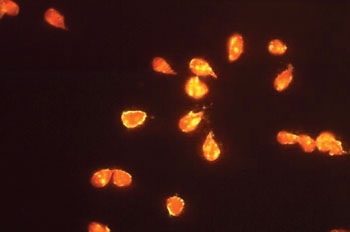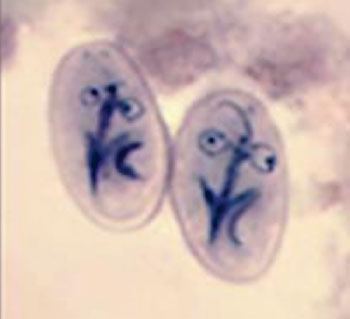Methods Compared for Detection of Fecal Giardiasis
By LabMedica International staff writers
Posted on 27 Mar 2016
Microscopy for intestinal protozoa after formol-ether (FE) or formol-ethylacetate (FEA) concentration is standard procedure for investigating patients with diarrhea where a protozoan etiology is suspected. Posted on 27 Mar 2016
In recent times, polymerase chain reaction (PCR) or fluorescence-labeled parasite-specific antibodies have been introduced for infections with intestinal protozoan parasites like Giardia duodenalis (syn. G. intestinalis and G. lamblia), Cryptosporidium but their place in everyday routine diagnostics has not yet been established.
Scientists at Aarhus University Hospital (Denmark) compared FEA and salt–sugar flotation (SSF) concentration followed by microscopy of iodine-stained concentrate and immunofluorescence assay (IFA) and real-time polymerase chain reaction (qPCR) for detection of Giardia duodenalis in human feces. Consecutive 455 fecal samples received between August 2012 and April 2013 at the hospital were included. FEA was performed within 48 hours after receipt of the samples. The samples were kept at + 4 °C for up to 90 days prior to qPCR analysis.
Immunofluorescence assays were performed on diluted feces after proper mixing, and a direct smear was made on Teflon coated slides containing three wells of 10 mm (Menzel Gläser, Braunschweig, Germany). The smears were left to air dry at room temperature overnight stained with FITC-labeled anti-Giardia antibodies (Cellabs; Brookvale Australia). Real-time polymerase chain reactions (qPCR) were performed where the crossing point-PCR-cycle (Cp) is the value given by the LightCycler 480 (Roche Diagnostics; Mannheim, Germany) and is similar to cycle threshold (Ct). It is the cycle at which fluorescence achieves a defined threshold.
The median number of Giardia cysts found by FEA in 19 Giardia-positive samples was 50 cysts per gram (CPG), by SSF 350 CPG, by IFA 76,700 CPG, and by qPCR 316,000 CPG. The team next tested 455 consecutive samples for presence of Giardia cysts. Using IFA as reference, qPCR had a sensitivity of 91%, specificity of 95.1%, a false-positive rate of 50%, a false-negative rate of 0.48%, a positive predictive value of 50%, and a negative predictive value of 99.5%.
The authors concluded that qPCR and IFA were significantly more sensitive than microscopy of iodine-stained concentrates using either FEA or SSF. They suggest, when using qPCR, that positive samples are verified by IFA to prevent false-positive results. The study was published in the March 2016 issue of the journal Diagnostic Microbiology and Infectious Disease.
Related Links:
Aarhus University Hospital
Menzel Gläser
Cellabs















